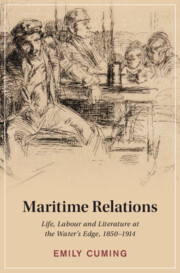Refine search
Actions for selected content:
608 results
Chapter 4 - Last Wills and Remembrance
-
- Book:
- The Will in English Renaissance Drama
- Published online:
- 04 September 2025
- Print publication:
- 18 September 2025, pp 130-165
-
- Chapter
- Export citation
Dignity in death: International humanitarian law and the protection of the deceased in war
-
- Journal:
- International Review of the Red Cross , First View
- Published online by Cambridge University Press:
- 12 September 2025, pp. 1-58
-
- Article
-
- You have access
- Open access
- HTML
- Export citation
Chapter 10 - Pieces of Walnut
- from Part I - Storying-to-Learn: How Stories-that-Matter Help Us Appreciate Social Work in Action
-
-
- Book:
- Learning through Social Work Stories-That-Matter
- Published online:
- 28 August 2025
- Print publication:
- 11 September 2025, pp 136-149
-
- Chapter
- Export citation
Chapter 2 - Logbooks
-
- Book:
- Maritime Relations
- Published online:
- 23 August 2025
- Print publication:
- 04 September 2025, pp 60-100
-
- Chapter
- Export citation
Introduction
-
- Book:
- Maritime Relations
- Published online:
- 23 August 2025
- Print publication:
- 04 September 2025, pp 1-17
-
- Chapter
- Export citation
Chapter 4 - The Sailor’s Daughter
-
- Book:
- Maritime Relations
- Published online:
- 23 August 2025
- Print publication:
- 04 September 2025, pp 140-181
-
- Chapter
- Export citation

Maritime Relations
- Life, Labour and Literature at the Water's Edge, 1850–1914
-
- Published online:
- 23 August 2025
- Print publication:
- 04 September 2025
1 - The Force of Destiny
- from Part I - The Ascent
-
- Book:
- The Generalissimo
- Published online:
- 31 July 2025
- Print publication:
- 14 August 2025, pp 13-42
-
- Chapter
- Export citation
Educational experience of children living with congenital heart disease: a systematic scoping review
-
- Journal:
- Cardiology in the Young / Volume 35 / Issue 8 / August 2025
- Published online by Cambridge University Press:
- 11 August 2025, pp. 1549-1557
-
- Article
-
- You have access
- Open access
- HTML
- Export citation
Chapter 5 - Devon
- from Part I - Key Places and Events
-
-
- Book:
- Sean O'Casey in Context
- Published online:
- 23 June 2025
- Print publication:
- 10 July 2025, pp 57-66
-
- Chapter
- Export citation
Chapter 19 - Eileen Carey (Eileen O’Casey)
- from Part III - Collaborators and Critics
-
-
- Book:
- Sean O'Casey in Context
- Published online:
- 23 June 2025
- Print publication:
- 10 July 2025, pp 202-211
-
- Chapter
- Export citation
6 - What’s Left? Religion and Welfare Policies in the Twenty-First Century in Italy and Germany
-
- Book:
- How Economic Ideas Evolve
- Published online:
- 06 June 2025
- Print publication:
- 10 July 2025, pp 154-175
-
- Chapter
- Export citation
Chapter 7 - Family Cults
- from Section 1 - Typology
-
-
- Book:
- A Clinical and Forensic Guide to Cults and Persuasive Leadership
- Published online:
- 19 June 2025
- Print publication:
- 03 July 2025, pp 132-140
-
- Chapter
- Export citation
The role of caregiver emotion regulation in youth mental health during the COVID-19 pandemic: A longitudinal study – CORRIGENDUM
-
- Journal:
- Development and Psychopathology / Volume 37 / Issue 4 / October 2025
- Published online by Cambridge University Press:
- 30 June 2025, p. 2250
-
- Article
- Export citation
9 - Social cultures and belonging
-
- Book:
- Intentional Practice with Infants and Toddlers
- Published online:
- 17 June 2025
- Print publication:
- 12 June 2025, pp 227-254
-
- Chapter
- Export citation
19 - Sexual Exploitation and Violence during the Holocaust
-
-
- Book:
- The Cambridge History of the Holocaust
- Published online:
- 16 May 2025
- Print publication:
- 12 June 2025, pp 314-329
-
- Chapter
- Export citation
3 - Lost In-between: Refugee Migration during the Holocaust
-
-
- Book:
- The Cambridge History of the Holocaust
- Published online:
- 16 May 2025
- Print publication:
- 12 June 2025, pp 53-67
-
- Chapter
- Export citation
6 - Selected Contemporary Approaches: The Feminist Family, Recentring Poverty, and Gender Diversity
-
- Book:
- Economics and the Family
- Published online:
- 08 May 2025
- Print publication:
- 05 June 2025, pp 220-259
-
- Chapter
- Export citation
1 - The Family and Its Problems in the History of Economics
-
- Book:
- Economics and the Family
- Published online:
- 08 May 2025
- Print publication:
- 05 June 2025, pp 1-35
-
- Chapter
- Export citation
5 - A Post-War ‘Underclass’ in Affluent North America: Black Family Instability, Human Capital Theory, and Gary Becker’s New Household Economics
-
- Book:
- Economics and the Family
- Published online:
- 08 May 2025
- Print publication:
- 05 June 2025, pp 174-219
-
- Chapter
- Export citation
